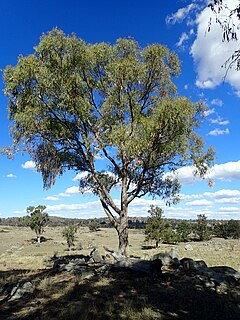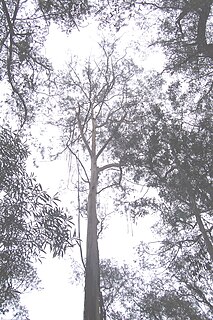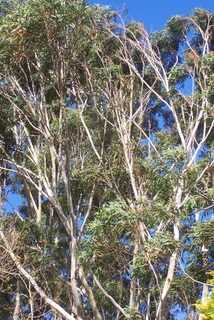
Eucalyptus delegatensis, commonly known as alpine ash, gum-topped stringybark, white-top and in Victoria as woollybutt, is a species of tree that is endemic to southeastern Australia. It has a straight trunk with rough, fibrous to stringy bark on the lower half of the trunk, smooth white bark above, lance-shaped to curved adult leaves, flower buds in groups of between seven and fifteen, white flowers and barrel-shaped or hemispherical fruit.

Eucalyptus dives, commonly known as the broad-leaved peppermint or blue peppermint, is a species of tree that is endemic to south-eastern Australia. It has rough, finely fibrous bark on the trunk and larger branches, smooth bark above, lance-shaped or curved adult leaves, flower buds in groups of eleven or more, white flowers and cup-shaped, hemispherical or conical fruit.

Eucalyptus nicholii, commonly known as the narrow-leaved black peppermint or willow peppermint, is a species of small to medium-sized tree that is endemic to New South Wales. It has thick, rough, fibrous bark on the trunk and branches, small, narrow adult leaves, flower buds arranged in groups of seven, white flowers and small, hemispherical, bell-shaped or conical fruit.

Eucalyptus nova-anglica, commonly known as the New England peppermint or black peppermint, is a species of small to medium-sized tree endemic to eastern Australia. It has thick, rough, fibrous bark on the trunk and larger branches, lance-shaped adult leaves, flower buds in groups of seven, white flowers and hemispherical or conical fruit.

Eucalyptus radiata, commonly known as the narrow-leaved peppermint or Forth River peppermint, is a species of tree that is endemic to south-eastern Australia. It has rough, fibrous to flaky bark on the trunk and larger branches, smooth grey bark on the thinner branches, lance-shaped to curved or almost linear leaves, flower buds in groups of eleven to twenty or more, white flowers and cup-shaped, hemispherical or shortenend spherical fruit.

Eucalyptus leucoxylon, commonly known as yellow gum, blue gum or white ironbark, is a species of small to medium-sized tree that is endemic to south-eastern continental Australia. It has smooth yellowish bark with some rough bark near the base, lance-shaped or curved adult leaves, flower buds in groups of three and cylindrical, barrel-shaped or shortened spherical fruit. A widely cultivated species, it has white, red or pink flowers.

Eucalyptus rubida, commonly known as candlebark, ribbon gum or white gum, is a species of small to medium-sized tree that is endemic to south-eastern Australia. It has smooth bark, sometimes with rough bark at the base, lance-shaped or curved adult leaves, flower buds in groups of three, white flowers and cup-shaped, hemispherical or bell-shaped fruit.

Eucalyptus smithii, commonly known as the gully gum, gully peppermint, blackbutt peppermint, or ironbark peppermint, is a species of medium-sized to tall tree, sometimes a mallee, that is endemic to southeastern Australia. It has rough, compact bark on the trunk, smooth ribbony bark above, narrow lance-shaped adult leaves, flower buds in groups of seven, white flowers and cup-shaped, bell-shaped or hemispherical fruit.

Eucalyptus pilularis, commonly known as blackbutt, is a species of medium-sized to tall tree that is endemic to eastern Australia. It has rough, finely fibrous greyish bark on the lower half of the trunk, smooth white, grey or cream-coloured bark above, lance-shaped to curved adult leaves, flower buds in groups of between seven and fifteen, white flowers and hemispherical or shortened spherical fruit.

Eucalyptus oreades, commonly known as the Blue Mountains ash, white ash or smooth-barked mountain ash, is a species of medium-sized to tall tree that is native to eastern Australia. It has smooth, powdery whitish bark with rough bark near the base, lance-shaped to curved adult leaves, flower buds in groups of seven, white flowers and cup-shaped to cylindrical fruit.
Eucalyptus nitida, commonly known as the Smithton peppermint, is a species of tree or mallee that is endemic to Tasmania. It has varying amounts of loose, fibrous or flaky bark, lance-shaped to curved adult leaves, flower buds in groups of nine to fifteen, white flowers and cup-shaped to hemispherical fruit.

Eucalyptus consideniana, commonly known as yertchuk, is a species of plant in the myrtle family and is endemic to south-eastern Australia. It is a tree with rough, fibrous, sometimes prickly bark on the trunk and larger branches, smooth grey bark above, lance-shaped or curved adult leaves, flower buds in groups of between eleven and nineteen, white flowers and conical to hemispherical fruit.

Eucalyptus pyrocarpa, commonly known as the large-fruited blackbutt, is a species of medium-sized tree that is endemic to New South Wales. It has rough bark on the trunk and larger branches, smooth grey to white bark above, lance-shaped to curved adult leaves, flower buds in groups of between seven and eleven, white flowers and cup-shaped, barrel-shaped or pear-shaped fruit.
Eucalyptus croajingolensis, commonly known as the East Gippsland peppermint or Gippsland peppermint, is a species of tree that is endemic to southeastern Australia. It has rough, short-fibrous bark on the trunk and larger branches, sometimes smooth bark on the thinner branches, lance-shaped to curved adult leaves, flower buds in groups of nine or more, white flowers and hemispherical to cup-shaped fruit.

Eucalyptus andrewsii, commonly known as the New England blackbutt, is a tree native to New South Wales and Queensland in eastern Australia. It is a tree with rough bark on the trunk and larger branches, lance-shaped often curved leaves, flower buds in groups of between eleven and fifteen and hemispherical or cup-shaped fruit.

Eucalyptus striaticalyx, commonly known as Cue York gum or kopi gum, is a species of tree or mallee that is endemic to Western Australia. It has thick, rough, fibrous bark on the trunk and larger branches, lance-shaped adult leaves, flower buds in groups of between seven and thirteen, creamy white flowers and conical to cup-shaped fruit.

Eucalyptus falciformis, commonly known as the Grampians peppermint or western peppermint, is a species of tree or mallee that is endemic to south eastern Australia. It has smooth bark, sometimes with rough, fibrous bark at the base, narrow lance-shaped to egg-shaped or curved adult leaves, flower buds in groups of eleven to twenty one, white flowers and cup-shaped to shortly cylindrical fruit.

Eucalyptus willisii, also known as shining peppermint or promontory peppermint, is a species of small to medium-sized tree, sometimes a mallee that is endemic to Victoria, Australia. It has rough, fibrous bark on the trunk and branches, lance-shaped to curved adult leaves, flower buds in groups of eleven to twenty five, white flowers and cup-shaped or hemispherical fruit.
Eucalyptus arenicola, commonly known as the Holey Plains peppermint or Gippsland Lakes peppermint, is a tree or mallee that is endemic to south-east coastal areas of Victoria. It has rough, fibrous bark on its trunk and branches, glossy green, lance-shaped adult leaves, club-shaped buds arranged in groups of eleven to twenty five, white flowers and cup-shaped to hemispherical fruit.
Eucalyptus rodwayi, commonly known as the swamp peppermint, is a species of small to medium-sized tree that is endemic to Tasmania. It has rough, fibrous to flaky bark on the trunk and branches, narrow lance-shaped adult leaves, flower buds in groups of between seven and eleven, white flowers and conical to hemispherical fruit.















